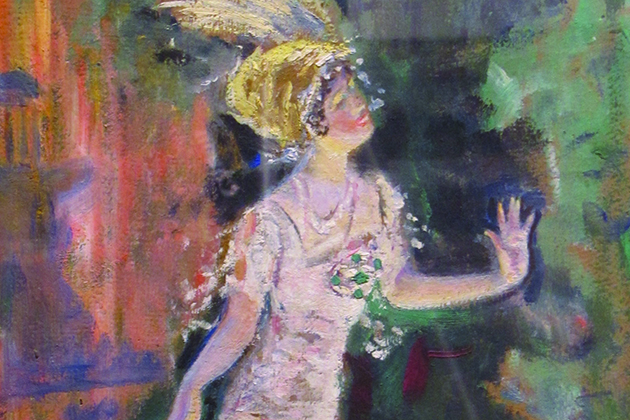
When Ally Walton ’12 MA began to think about curating the art exhibition tied to F. Scott Fitzgerald’s “The Great Gatsby,” this year’s UConn Reads selection, images from the novel were prominent in her memory.
“I read the book in high school, as everybody did. It was one of the books that stuck with me the most,” says Walton, assistant curator at The William Benton Museum of Art and curator for the exhibition “Millionaires and Mechanics, Bootleggers and Flappers: Speaking of ‘The Great Gatsby’.”
She says images of New York City and great wealth, symbolized by the color green in the novel, resonated as she began to think about works of art from the era when the book was published.
“When I started the task of creating an exhibition around the book, I started with those images,” Walton says. “I had developed a checklist before semester break and then re-read the book over break, pulling out some quotes that resonated with the visual work I’d selected. I also spoke with professors in the Department of Art and Art History.”
The result is a multimedia exhibition comprised of early 20th-century paintings and works on paper, including watercolors, photographs, and prints that recall the gilded age of the 1920s, a time marked by overt displays of wealth, widespread urbanization, and dizzying modernity.
“All of the work is from the Benton’s permanent collection, and most was created during the 1920s, the decade in which the story is set and when the book was published,” Walton says. “Some outliers from the early 1900s and the 1930s are also on view, which help to give shape to the state of American art during the early 20th century.”
Some of the featured works in the exhibition are prints by Reginald Marsh, noted for his focus on New York life, and an oil painting by Everett Shinn of the Ashcan School, known for offering scenes from the theatre. Also on view is a photograph by Paul Strand, who helped move American photography away from the soft-focused style of Pictorialism toward a more hard-edged representation of modern times; and prints by Peggy Bacon, known for her caricatures, and Edward Hopper, who depicted modern life in his paintings and etchings.

Walton notes that two oil paintings by Walt Kuhn that are adjacent to each other in the exhibition reflect the two main female characters in the novel, Daisy Buchanan, cousin of the book’s narrator Nick Carraway and loved by Jay Gatsby, and her friend, Jordan Baker, who becomes involved with Nick over the course of the story.
“Study for Bareback Rider” (1926) and “Jeannette” (1928) are each characteristic of the vaudeville and circus themes depicted by modernists such as Kuhn, who helped bring the European avant-garde to the attention of American audiences through the Armory Show of 1913.
“Kuhn took a unique perspective in really isolating his performers so they’re not seen in the setting they were paid to perform in,” Walton says. “They still point back to their work in their costumes, but with a little melancholy or boredom in their expression brought about by the daily onstage performance their profession requires. Jordan Baker is a golfer also contemptuous, jaded in her outlook on the world. ‘Study for Bareback Rider’ resonates with that character, whereas ‘Jeannette’ seems to fall in line with Daisy Buchanan, charming, opulent, and beautiful. These are performers, and these female characters in the book also seem to be performing.”
Ilse Bing’s silver print, “Queensborough Bridge Exit with One Car” (1936), helps link the characters as they travel from West Egg and East Egg, where many of them live, to Manhattan, where they either work or enjoy nightlife. The approach to the bridge, better known as the 59th Street Bridge, evoked special descriptions by both the photographer and Fitzgerald as they thought about the New York skyline.
“[Bing] said the New York City skyline reminded her of crystals coming out of a mountain, a natural crystalized growth,” says Walton. “It seems to be similar to how Fitzgerald describes the skyline while crossing the bridge, as seeing sugar lumps on the horizon.”

Two works, “Night Shadows’ (1921), an etching by Hopper, and “Wall Street, New York” (1915), a photograph by Strand, visualize comments in the novel by narrator Carraway, when he talks about how the sun casts his shadow on the sidewalks of the city as he walks to work.
Five etchings by Marsh show the daily life of commuters in New York City as they ride elevated trains on the Brooklyn-Manhattan Transit (BMT) lines. Men and women are seen talking, reading, and lost in thought.
“These are great social portraits on the expanding metropolis that New York was at that time,” says Walton. “You can see the elevated railing and the skylines through the windows of the car. You have a really great look at the fashion of the period through the way women and men are dressed. Marsh does a nice thing where he provides viewers with visible newspaper headlines that refer to actual events and people, so we can think about things that were happening at the time.”
“Millionaires and Mechanics, Bootleggers and Flappers: Speaking of ‘The Great Gatsby’” will continue in the East Gallery of The William Benton Museum of Art through March 17.



